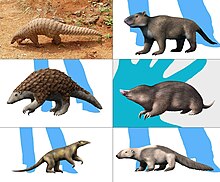| Pholidotamorphs Temporal range: Paleocene–Recent PreꞒ Ꞓ O S D C P T J K Pg N | |
|---|---|

| |
| Various Pholidotamorph genera; clockwise from top left: Manis, Ernanodon, Xenocranium, Metacheiromys, Eurotamandua, Eomanis. | |
| Scientific classification | |
| Domain: | Eukaryota |
| Kingdom: | Animalia |
| Phylum: | Chordata |
| Class: | Mammalia |
| Mirorder: | Ferae |
| Clade: | Pholidotamorpha Gaudin et al., 2009 |
| Orders | |
Pholidotamorpha ("pangolin-like forms") is a clade of placental mammals from mirorder Ferae that includes the order Pholidota (the pangolins) and extinct order Palaeanodonta.
Classification and phylogeny
History of taxonomy
Both the Pholidota and Palaeanodonta orders were formerly classified with various other orders of ant-eating mammals, most notably Xenarthra (armadillos, sloths and true anteaters) which they superficially resemble. Some past palaeontologists placed pangolins and palaeanodonts as a suborder "Pholidota" in order Cimolesta, alongside the extinct family Ernanodontidae as a separate suborder Ernanodonta near it, but this idea fell out of favor when it was determined that cimolestids were not placental mammals.
Newer genetic evidence indicates instead that the closest living relatives to order Pholidota are the members of order Carnivora, and together they form the mirorder Ferae. In 2009, pangolins and palaeanodonts were together placed within clade Pholidotamorpha. A 2012 study from new remains found in Late Paleocene Mongolian strata have led to the assessment that extinct genus Ernanodon is closely related to extinct genus Metacheiromys and being a member of the extinct order Palaeanodonta.
Classification
- Clade: Pholidotamorpha (Gaudin, 2009)
- Order: Pholidota (Weber, 1904) (pangolins)
- Suborder: Eupholidota (Gaudin, 2009) (true pangolins)
- Family: †Eurotamanduidae (Szalay & Schrenk, 1994)
- Genus: †Euromanis (Gaudin, 2009)
- Incertae sedis
- †Pholidota sp. (Pickford, 2008)
- Order: †Palaeanodonta (Matthew, 1918) (stem-pangolins)
- Family: †Epoicotheriidae (Simpson, 1927)
- Family: †Ernanodontidae (Ding, 1979)
- Family: †Escavadodontidae (Rose & Lucas, 2000)
- Family: †Metacheiromyidae (Wortman, 1903)
- Incertae sedis:
- Genus: †Arcticanodon (Rose, 2004)
- Genus: †Melaniella (Fox, 1984)
- Order: Pholidota (Weber, 1904) (pangolins)
Phylogeny
The phylogenetic relationships of clade Pholidotamorpha are shown in the following cladogram:
| Ferae |
|
†Epoicotherium/Xenocranium clade†Metacheiromyidae | ||||||||||||||||||||||||||||||||||||||||||||||||||||||||||||||||||||||||||||||||||||||||||||||||||||||||||||||||||||||||||||||
See also
References
- ^ Gaudin, Timothy (2009). "The Phylogeny of Living and Extinct Pangolins (Mammalia, Pholidota) and Associated Taxa: A Morphology Based Analysis" (PDF). Journal of Mammalian Evolution. 16 (4). Heidelberg, Germany: Springer Science+Business Media: 235–305. doi:10.1007/s10914-009-9119-9. S2CID 1773698. Archived from the original (PDF) on 2015-09-25. Retrieved 2020-08-05.
- Rook, D. L.; Hunter, J. P. (2013). "Rooting Around the Eutherian Family Tree: the Origin and Relations of the Taeniodonta". Journal of Mammalian Evolution. 21: 1–17. doi:10.1007/s10914-013-9230-9. S2CID 17074668.
- Murphy, Willian J., et al. (2001-12-14). "Resolution of the Early Placental Mammal Radiation Using Bayesian Phylogenetics". Science. 294 (5550): 2348–2351. Bibcode:2001Sci...294.2348M. doi:10.1126/science.1067179. PMID 11743200. S2CID 34367609.
- Beck, Robin MD; Bininda-Emonds, Olaf RP; Cardillo, Marcel; Liu, Fu-Guo; Purvis, Andy (2006). "A higher-level MRP supertree of placental mammals". BMC Evolutionary Biology. 6 (1): 93. doi:10.1186/1471-2148-6-93. PMC 1654192. PMID 17101039.
- Mark S Springer, Christopher A Emerling, John Gatesy, Jason Randall, Matthew A. Collin, Nikolai Hecker, Michael Hiller, Frédéric Delsuc (2019) Odontogenic ameloblast-associated (ODAM) is inactivated in toothless/enamelless placental mammals and toothed whales
- ^ Kondrashov, Peter; Agadjanian, Alexandre K. (2012). "A nearly complete skeleton of Ernanodon (Mammalia, Palaeanodonta) from Mongolia: morphofunctional analysis". Journal of Vertebrate Paleontology. 32 (5): 983–1001. doi:10.1080/02724634.2012.694319. ISSN 0272-4634. S2CID 86059673.
- Amrine-madsen, H.; Koepfli, K.P.; Wayne, R.K.; Springer, M.S. (2003). "A new phylogenetic marker, apolipoprotein B, provides compelling evidence for eutherian relationships". Molecular Phylogenetics and Evolution. 28 (2): 225–240. doi:10.1016/S1055-7903(03)00118-0. PMID 12878460.
- Kenneth D. Rose (2008). "Palaeanodonta and Pholidota". 9 - Palaeanodonta and Pholidota. pp. 135–146. doi:10.1017/CBO9780511541438.010. ISBN 9780521781176.
- Halliday, Thomas J. D.; Upchurch, Paul; Goswami, Anjali (2015). "Resolving the relationships of Paleocene placental mammals" (PDF). Biological Reviews. 92 (1): 521–550. doi:10.1111/brv.12242. ISSN 1464-7931. PMC 6849585. PMID 28075073.
- Solé, Floréal; Ladevèze, Sandrine (2017). "Evolution of the hypercarnivorous dentition in mammals (Metatheria,Eutheria) and its bearing on the development of tribosphenic molars". Evolution & Development. 19 (2): 56–68. doi:10.1111/ede.12219. PMID 28181377. S2CID 46774007.
- Prevosti, F. J., & Forasiepi, A. M. (2018). "Introduction. Evolution of South American Mammalian Predators During the Cenozoic: Paleobiogeographic and Paleoenvironmental Contingencies"
| Mammals of clade Pholidotamorpha | |||||||||||||||||||||||||||||||||||||||||||||||||||
|---|---|---|---|---|---|---|---|---|---|---|---|---|---|---|---|---|---|---|---|---|---|---|---|---|---|---|---|---|---|---|---|---|---|---|---|---|---|---|---|---|---|---|---|---|---|---|---|---|---|---|---|
| |||||||||||||||||||||||||||||||||||||||||||||||||||
| Pholidotamorpha |
| ||||||||||||||||||||||||||||||||||||||||||||||||||
| Taxon identifiers | |
|---|---|
| Pholidotamorpha | |
This prehistoric mammal-related article is a stub. You can help Misplaced Pages by expanding it. |